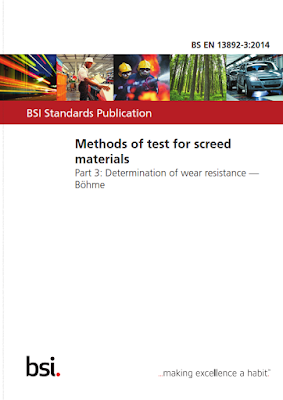In parts of Europe, BS EN 13892-3(4) is commonly cited in specifications
for floors. This is a laboratory test known as the Böhme test and is used for
testing screed materials. It is usually cited in respect of dry-shake toppings
used on floors. It is difficult to see the relevance of this test method as the
manufactured test specimen used in the laboratory cannot be representative of
the actual floor.
Dry-shake toppings are blends of cement and fine aggregates, sometimes
together with wetting agents and or pigments. In principle, a dry-shake topping
has the same basic components as the fine aggregate and cement in concrete, ie,
the mortar paste element. It follows that for the dry-shake topping to enhance
abrasion resistance over and above the base concrete in a floor, the topping
must have property enhancing characteristics.
In most cases, toppings are supplied as fibre suppressants and are
associated with steel-fibre-reinforced floors. The prime purpose of the topping
is to boost the volume of mortar paste at the surface to give greater coverage
potential over the close-to-surface fibres.
A recent trend has been to use lithium or sodium silicate as surface
hardeners / floor hardeners. Traditionally, sodium silicate (water-glass) was
used on concrete floor surfaces to deal with dusting problems caused by
inadequate curing or other deficiencies. The silicate compound reacts with
excess portlandite formed during cement hydration to form stable compounds.
Determination of
wear resistance —
Böhme
The disc abrader conforming to Böhme method consists of a rotating
wheel made of cast iron, 750 mm dia., with a defined test track to receive
the abrasive material (white corundum sand) and a no-vibration specimen
holder with a two-arm lever loading device.
The test specimen is clamped with a holder and submitted to a test force of 294 +/-3 N. After the abrasive is strew on the disc, the disc starts to rotate with a constant speed for a certain number of cycles (according to Standards). At the end of the test the abrasion effect is measured as the loss in specimen thickness or volume. |
This machine is used for testing of:
§ natural stones (EN 14157)
§ concrete paving blocks (EN 1338), flags (EN 1339) and kerbs (EN 1340)
§ screed materials (EN 13892-3)
§ terrazzo tiles (EN 13748-2)
Screed material cubes
with edge length of (71 ± 1,5) mm shall be used as specimens. Alternatively,
square blocks, of the same edge length, but a minimum thickness of 30 mm
including any support slab may be used. The test specimen shall be dried at
(110 ± 5) °C until constant mass.
Let see the testing process:
Expression of results of the wear
resistance Böhme after 16 cycles shall be determined as the loss in specimen
volume in cm3 per 50 cm2
Many thanks for
google.com, academicjournals.org, http://www.controls-group.com, from where the details are collected.



No comments:
Post a Comment